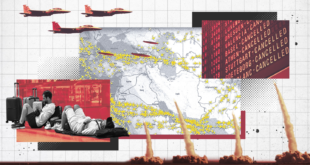
Who remembers the last operation that al-Qaeda claimed responsibility for? For many people, the answer will need s ome thought.
This question aims to shed light on what appears to be a clear decline of Qaeda’s role in planning and carrying out terrorist attacks around the world.
Qaeda’s activity began to recede during the leadership of Osama bin Laden. But its waning became more evident in the nine years that followed the man’s killing by the US commando raid on his hideout in Abbottabad, Pakistan on the first of May, 2011 (US time).
A review conducted by Asharq Al-Awsat on the press publications, which were issued by Qaeda under the leadership of Ayman al-Zawahiri, showed that the “general leadership” of the “jihad base” has turned from a direct base for attacks around the world to a promoter of operations in the areas of the group’s deployment.
It also appears, based on these publications, that al-Zawahiri leads the organization with the help of another Egyptian leader named Hossam Abdel-Raouf, also known as Abu Mohsen, who is in charge of the media activities.
A report by a US research center mentioned that there was another leader in the organization’s leadership assisting al-Zawahiri. It is his son-in-law, Abdul-Rahman al-Maghribi, who was reportedly killed in Waziristan in 2006. The current reports by Qaeda leadership do not include any indication that al-Maghribi is still alive.
In addition to Al-Zawahiri and Abu Mohsen, Qaeda’s publications highlight a series of audiotapes of Hamza bin Laden, Osama’s son, who in turn called for carrying out attacks in revenge for his father’s death. He also urged the organization’s supporters to launch “lone-wolves” attacks in western and Arab countries.
Back then, Hamza was assuming an increasingly important position in the organization, which reinforced reports that he was preparing to be a potential successor to al-Zawahiri.
In a statement issued by the White House in September 2019, US President Donald Trump announced that Hamza bin Laden was killed in a US counterterrorism operation in the Afghanistan-Pakistan border region.
His killing was part of US efforts to combat Qaeda’s activity and to deprive the group of a long succession of leaders, who were killed by raids often launched by drones on their hideouts in Waziristan on the Pakistani border with Afghanistan.
Many thought that the Arab world’s revolutions, known as “the Arab Spring” would constitute an opportunity for Qaeda’s revival.
However, the organization’s new leader, Ayman al-Zawahiri, seemed unable to reap the “fruits of the spring”, not only as a result of US pressure, but also because of the emergence of a fierce competitor from within its environment: ISIS.
Al-Baghdadi…The Decline of al-Qaeda
The emergence of ISIS, led by Abu Bakr Al-Baghdadi, reflected the waning of al-Qaeda stars under Al-Zawahiri.
In the years that saw the movement’s rise, precisely in 2012, Baghdadi refused to submit to al-Zawahiri’s orders, specifically regarding al-Nusra Front, and went as far as to destroy the organization and eliminate its presence in large areas of Syria, in addition to competing with Qaeda in its strongholds around the world.
ISIS gained further strength through the field victories achieved by its fighters in Iraq and Syria. They took control of an area equivalent to the size of Britain, and established a “state”, which they called the “caliphate” in 2014. These successes attracted thousands of people from around the world, who flocked to Syria and Iraq. Many of them brought their families along to live in the purported “confines of the caliphate”.
Also, Baghdadi has resorted to a series of massive attacks in Western countries, some of which were carried out directly, as happened in the Paris and Brussels attacks of 2015 and 2016; while others were perpetrated indirectly, through a long series of “lone-wolves” attacks, carried out by ISIS supporters, who were unable to join in Syria and Iraq, due to the launching of operations of the international coalition against the organization.
Through these attacks, ISIS became the world’s first terrorist organization in the eyes of the Americans, who had previously honored Qaeda with that title.
However, Qaeda was severely battered by ISIS in Syria, where al-Zawahiri was betting on reviving his organization’s activity through al-Nusra Front, which was led by Abu Muhammad al-Jolani.
Qaeda, as it turned out, sent a number of its most distinguished veteran leaders and well-known figures (some of whom were residing in Iran) to Syria to empower al-Nusra against ISIS, on the one hand, and allow it to attract other groups that were also fighting the Syrian regime under Islamic slogans.
But the Americans knew that al-Nusra was nothing but a branch of Qaeda. The leader of the group, Abu Muhammad al-Jolani, was forced to reject his allegiance to al-Zawahiri.
This disagreement prompted some of the Font’s senior members to declare their separation from al-Jolani and form another organization openly linked to Qaeda, under the name of “Guardians of the Religion”.
It was clear that the Syrian issue and the Islamists’ differences worried Zawahiri since the rise of Baghdadi in 2013.
In September 2015, Zawahiri called on his supporters to cooperate with ISIS in Syria and Iraq to counter the campaign launched by the international coalition against the organization. However, this did not lead to an improvement in relations between the two parties, but rather to its further deterioration.
Qaeda Branches
Apart from the Syrian defeat, Qaeda branch in East Africa, represented by the Somali al-Shabab movement, maintained the momentum of its activity, carrying out a series of attacks in the disintegrated Somalia and its neighbor, Kenya.
The US Command in Africa (AFRICOM) plays a pivotal role in facing al-Shabab, through a series of raids targeting the locations of the movement’s militants.
Since the beginning of 2020, AFRICOM has carried out more than 33 raids against al-Shabab, and has managed to kill many elements, including one of its founders, Yusuf Jiis, in April this year.
The Qaeda branch in the African Sahel region, represented by the Islamic and Muslim Front, was able to maintain the pace of its activities in Niger, Burkina Faso and Mali – countries, where central governments suffer disintegration and their security forces, are unable to control large areas of their vast territories.
These countries also witness the activity of the ISIS branch, which has claimed responsibility huge operations in Burkina Faso, Niger, Nigeria, and the region surrounding Lake Chad. The future relationship between the two terrorist movements is still unclear, given that they are currently coexisting.
In Yemen, Qaeda lost its leader, Qasim Al-Rimi (Abu Hurairah Al-Sanani), in a US raid early this year. In February, Trump announced the killing of al-Rimi, who had taken over the leadership of Qaeda there since 2015. He was succeeded by Khaled Bin Omar Batarfi.
In Afghanistan and Pakistan, Qaeda welcomed the US agreement with the Taliban movement, although this agreement clearly states the Taliban will not allow any activity launched from its territory against external parties, including the US
Qaeda Leadership After The Killing of Hamza Bin Ladan
Not much is currently known about those helping Zawahiri lead the organization, especially after the killing of Hamza bin Laden.
But Qaeda’s publications sometimes refer to another Egyptian figure, who appears to be playing an important role in the hierarchy of the organization: Hossam Abdel-Raouf, who is presented as Qaeda’s media official.
Last year, the US Federal Bureau of Investigation (FBI) added him to the lists of most wanted people, noting that he was nicknamed “Abu Mohsen al-Masri,” born in Egypt in 1957.
In 2018, a US court charged him with conspiracy to provide material support and resources for a foreign terrorist organization.
Meanwhile, the relationship between Qaeda and ISIS is still mired in ambiguity in the wake of the US success in defeating the latter in Syria and the killing of Zawahri’s first rival, Baghdadi, in Idlib in October last year.
ISIS chose a new leader, Amir Muhammad Saeed Abdul Rahman al-Mawla (known as Abu Ibrahim al-Qurashi, Hajji Abdullah and Abu Omar al-Turkmani), who previously assumed a religious role in the ranks of Qaeda in Iraq.
Thus, Zawahiri will find himself now in confrontation with a new leader of ISIS, who emerged from the heart of Qaeda.
 Eurasia Press & News
Eurasia Press & News


